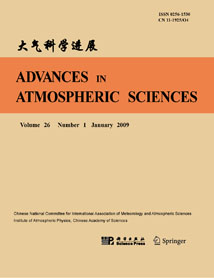| [1] |
B.Parthasarathy, Song Yang,
1995: Relationships between Regional Indian Summer Monsoon Rainfall and Eurasian Snow Cover, ADVANCES IN ATMOSPHERIC SCIENCES, 12, 143-150.
doi: 10.1007/BF02656828
|
| [2] |
S. V. Singh, S. R. Inamdar, R. H. Kripalani, K. D. Prasad,
1986: RELATIONSHIP BETWEEN 500 hPa RIDGE AXIS POSITIONS OVER THE INDIAN AND THE WEST PACIFIC REGIONS AND THE INDIAN SUMMER MONSOON RAINFALL, ADVANCES IN ATMOSPHERIC SCIENCES, 3, 349-359.
doi: 10.1007/BF02678655
|
| [3] |
Yuan Zhuojian, Wang Tongmei, He Haiyan, Luo Huibang, Guo Yufu,
2000: A Comparison between Numerical Simulations of Forced Local Hadley (Anti-Hadley) Circulation in East Asian and Indian Monsoon Regions, ADVANCES IN ATMOSPHERIC SCIENCES, 17, 538-554.
doi: 10.1007/s00376-000-0017-6
|
| [4] |
Zhu Qiangen, He Jinhai, Wang Panxing,
1986: A STUDY OF CIRCULATION DIFFERENCES BETWEEN EAST-ASIAN AND INDIAN SUMMER MONSOONS WITH THEIR INTERACTION, ADVANCES IN ATMOSPHERIC SCIENCES, 3, 466-477.
doi: 10.1007/BF02657936
|
| [5] |
LIU Xiangwen, WU Tongwen, YANG Song, LI Qiaoping, CHENG Yanjie, LIANG Xiaoyun, FANG Yongjie, JIE Weihua, NIE Suping,
2014: Relationships between Interannual and Intraseasonal Variations of the Asian-Western Pacific Summer Monsoon Hindcasted by BCC_CSM1.1(m), ADVANCES IN ATMOSPHERIC SCIENCES, 31, 1051-1064.
doi: 10.1007/s00376-014-3192-6
|
| [6] |
S. S. Dugam, S. B. Kakade, R. K. Verma,
1990: Global Annual Mean Surface Air Temperature Anomalies and Their Link with Indian Summer Monsoon Failures, ADVANCES IN ATMOSPHERIC SCIENCES, 7, 245-248.
doi: 10.1007/BF02919162
|
| [7] |
Yiran GUO, Jie CAO, Hui LI, Jian WANG, Yuchao DING,
2016: Simulation of the Interface between the Indian Summer Monsoon and the East Asian Summer Monsoon: Intercomparison between MPI-ESM and ECHAM5/MPI-OM, ADVANCES IN ATMOSPHERIC SCIENCES, 33, 294-308.
doi: 10.1007/s00376-015-5073-z
|
| [8] |
XU Yongfu, LI Yangchun, and CHU Min,
2013: A Global Ocean Biogeochemistry General Circulation Model and its Simulations, ADVANCES IN ATMOSPHERIC SCIENCES, 30, 922-939.
doi: 10.1007/s00376-012-2162-0
|
| [9] |
YU Yongqiang, ZHANG Xuehong, GUO Yufu,
2004: Global Coupled Ocean-Atmosphere General Circulation Models in LASG/IAP, ADVANCES IN ATMOSPHERIC SCIENCES, 21, 444-455.
doi: 10.1007/BF02915571
|
| [10] |
Zhang Ronghua, Zeng Qingcun, Zhou Guangqing, Liang Xinzhong,
1995: A Coupled General Circulation Model for the Tropical Pacific Ocean and Global Atmosphere, ADVANCES IN ATMOSPHERIC SCIENCES, 12, 127-142.
doi: 10.1007/BF02656827
|
| [11] |
Xue Feng,
2001: Interannual to Interdecadal Variation of East Asian Summer Monsoon and its Association with the Global Atmospheric Circulation and Sea Surface Temperature, ADVANCES IN ATMOSPHERIC SCIENCES, 18, 567-575.
doi: 10.1007/s00376-001-0045-x
|
| [12] |
Xia ZHAO, Dongliang YUAN, Guang YANG, Hui ZHOU, Jing WANG,
2016: Role of the Oceanic Channel in the Relationships between the Basin/Dipole Mode of SST Anomalies in the Tropical Indian Ocean and ENSO Transition, ADVANCES IN ATMOSPHERIC SCIENCES, 33, 1386-1400.
doi: 10.1007/s00376-016-6048-4
|
| [13] |
XUN Xueyi, HU Zeyong, MA Yaoming,
2012: The Dynamic Plateau Monsoon Index and Its Association with General Circulation Anomalies, ADVANCES IN ATMOSPHERIC SCIENCES, 29, 1249-1263.
doi: 10.1007/s00376-012-1125-9
|
| [14] |
WU Bingyi,
2005: Weakening of Indian Summer Monsoon in Recent Decades, ADVANCES IN ATMOSPHERIC SCIENCES, 22, 21-29.
doi: 10.1007/BF02930866
|
| [15] |
S.G. Narkhedkar,
1995: The Variability of the Interannual Oscillations of the Indian Summer Monsoon Rainfall, ADVANCES IN ATMOSPHERIC SCIENCES, 12, 95-102.
doi: 10.1007/BF02661291
|
| [16] |
Tim LI, ZHANG Lei, Hiroyuki MURAKAMI,
2015: Strengthening of the Walker Circulation under Global Warming in an Aqua-Planet General Circulation Model Simulation, ADVANCES IN ATMOSPHERIC SCIENCES, 32, 1473-1480.
doi: 10.1007/s00376-015-5033-7
|
| [17] |
Boyin HUANG, Vikram M. MEHTA,
2010: Influences of Freshwater from Major Rivers on Global Ocean Circulation and Temperatures in the MIT Ocean General Circulation Model, ADVANCES IN ATMOSPHERIC SCIENCES, 27, 455-468.
doi: 10.1007/s00376-009-9022-6
|
| [18] |
Zhang Minghua, Yu Rucong, Yu Yongqiang,
2001: Comparing Cloud Radiative Properties between the Eastern China and the Indian Monsoon Region, ADVANCES IN ATMOSPHERIC SCIENCES, 18, 1090-1102.
doi: 10.1007/s00376-001-0025-1
|
| [19] |
A. Longhetto, S. Ferrarese, C. Cassardo, C. Giraud, F. Apadttla, P. Bacci, P. Bonelli, A. Marzorati,
1997: Relationships between Atmospheric Circulation Patterns and CO2 Greenhouse-Gas Concentration Levels in the Alpine Troposphere, ADVANCES IN ATMOSPHERIC SCIENCES, 14, 309-322.
doi: 10.1007/s00376-997-0052-7
|
| [20] |
Tao Zuyu,
1989: Analysis of Indian Monsoon and Associated Low-Level Circulation in 1980 and 1981, ADVANCES IN ATMOSPHERIC SCIENCES, 6, 113-119.
doi: 10.1007/BF02656922
|















 AAS Website
AAS Website 
 AAS WeChat
AAS WeChat 
 DownLoad:
DownLoad: